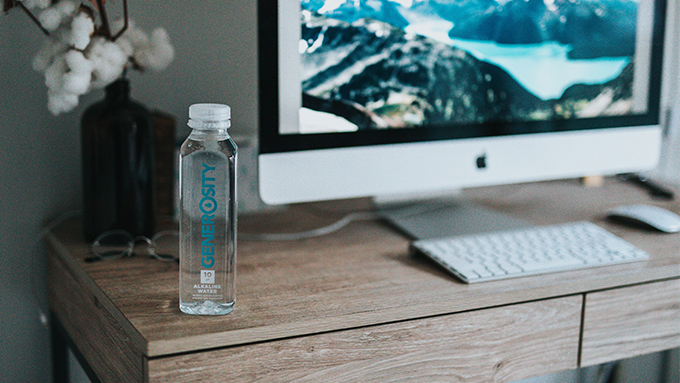Relationship Between Fluid Intake and Hydration Levels in Workers: Literature Review

Background:Dehydration is a condition of lack of fluids in the body because the amount of fluid that comes out is greater than the amount that goes in. Workers are people at risk of dehydration due to insufficient fluid replacement because fluid intake does not meet needs and there is an increase in fluid expenditure. Ensuring workers are adequately hydrated is one way to improve workplace safety and productivity.
Objectives: Determine the relationship between fluid intake and hydration status in workers.
Methods: This study used literature review method. The literature study was conducted by choosing a cross-sectional design. This study using a electronic databases search strategy from international and national journals.
Discussion: There was a significant relationship between fluid intake and workers' hydration status. The majority of workers are dehydrated due to low fluid intake.
Conclusions: The conclusion is that fluid intake affects hydration status, but there are several factors such as ambient conditions and type of liquid.
Adisiswanto, E. (2003) ‘Perlindungan Terhadap Tenaga Kerja Wanita yang Bekerja Pada Malam Hari di Perusahaan', pp. 69–75.
Andayani, K. and Dieny, F. F. (2013) ‘Hubungan Konsumsi Cairan Dengan Status Hidrasi Pada Pekerja Industri Laki-Laki', Journal of Nutrition College, 2(4), pp. 547–556. doi: 10.14710/jnc.v2i4.3738.
Bates, G. et al. (2001) ‘Fluid Intake and Hydration Status of Forest Workers -- A Preliminary Investigation', International Journal of Forest Engineering, 12(2), pp. 27–32. doi: 10.1080/14942119.2001.10702443.
Cerika Rismayanthi, R. I. R. (2016) ‘Hubungan Antara Status Hidrasi Serta Konsumsi Cairan Pada Atlet Bola Basket', Medikora, 15(1), pp. 53–67. doi: 10.21831/medikora.v15i1.10068.
Cheung, S. S. and Daanen, H. A. M. (2012) ‘Dynamic Adaptation of the Peripheral Circulation to Cold Exposure', Microcirculation, 19(1), pp. 65–77. doi: 10.1111/j.1549-8719.2011.00126.x.
Deviani, M. and Safitri, A. (2019) Hubungan Konsumsi Cairan Dengan Status Hidrasi Pemetik Daun Teh Pt Rumpun Sari. Universitas Diponegoro. Available at: eprints.undip.ac.id/41853/1/569_KHAIRUNISSA_ANDAYANI_G2C009073.pdf.
Effendi, A. (2016) Hubungan Iklim Kerja dengan Tingkat Dehidrasi Pekerja Home Industry STMJ Surabaya. Universitas Airlangga.
Fatimah, E. and Haryati, S. (2020) ‘Hubungan Konsumsi Air Dengan Status Hidrasi Pada Pekerja Kebersihan Rs Kasih Ibu'.
Habibati, A. F., Lailatus, U. and Sulistyorini, L. (2022) ‘Hubungan Asupan Cairan dan Iklim Kerja dengan Status Hidrasi Pekerja Home Industry Keripik Pisang Lumajang Relationship of Fluid Intake And Work Climate with Hydration Status of Workers Home Industry Banana Chips Lumajang', pp. 4–8.
Institute of Medicine of the National Academies (2005) Dietary reference intakes for water, potassium, sodium, chloride, and sulfate, Dietary Reference Intakes for Water, Potassium, Sodium, Chloride, and Sulfate. doi: 10.17226/10925.
Kenefick, R. W. and Sawka, M. N. (2007) ‘Hydration at the Work Site', Journal of the American College of Nutrition, 26(October 2014), pp. 597S-603S. doi: 10.1080/07315724.2007.10719665.
Kurniawati, F. et al. (2021) ‘Hubungan Pengetahuan, Konsumsi Cairan dan Status Gizi dengan Status Hidrasi pada Kurir Ekspedisi Relationship between Knowledge, Fluid Intake and Nutritional Status with Hydration Status of Expedition Couriers', Jurnal Riset Gizi, 9(1), pp. 46–52. doi: 10.31983/jrg.v9i1.6428.
Lim, Y. H. et al. (2015) ‘Effects of cold and hot temperature on dehydration: a mechanism of cardiovascular burden', International Journal of Biometeorology, 59(8), pp. 1035–1043. doi: 10.1007/s00484-014-0917-2.
Lufyana, R. D. W. I. (2020) Hubungan Konsumsi Air Minum dan Iklim Kerja Dengan Dehidrasi Pada Pekerja Konstruksi di Surabaya. Universitas Airlangga.
Puspita, A. D. and Widajati, N. (2020) ‘Gambaran Iklim Kerja Dan Tingkat Dehidrasi Pekerja Shift Pagi Di Bagian Injection Moulding 1 Pt.X Sidoarjo', Journal of Public Health Research and Community Health Development, 1(1), p. 13. doi: 10.20473/jphrecode.v1i1.20452.
Pustisari, F. et al. (2020) ‘Hubungan Aktivitas Fisik, Konsumsi Cairan, Status Gizi Dan Status Hidrasi Pada Pekerja Proyek', Jurnal Gizi, 9(2), p. 215. doi: 10.26714/jg.9.2.2020.215-223.
Ratih, A. and Fithra, F. (2017) ‘Hubungan Konsumsi Cairan Dengan Status Hidrasi Pekerja Di Suhu Lingkungan Dingin', Journal of Nutrition College, 6(1), pp. 76–83. Available at: https://ejournal3.undip.ac.id/index.php/jnc/article/view/16896/17175.
Rismayanthi, C. (2012) ‘Persepsi Atlet Terhadap Macam, Fungsi Cairan, dan Kadar Hidrasi Tubuh di Unit Kegiatan Mahasiswa Olahraga Universitas Negeri Yogyakarta'.
Sari, M. P. (2017) ‘Iklim Kerja Panas dan Konsumsi Air Minum Saat Kerja Terhadap Dehidrasi', HIGEIA (Journal of Public Health Research and Development), 1(2), pp. 108–118. Available at: http://journal.unnes.ac.id/sju/index.php/higeia.Sari, N. A. and Nindya, T. S. (2018) ‘Hubungan Asupan Cairan, Status Gizi Dengan Status Hidrasi Pada Pekerja Di Bengkel Divisi General Engineering PT Pal Indonesia', Media Gizi Indonesia, 12(1), p. 47. doi: 10.20473/mgi.v12i1.47-53.
Sawka, M. N. (2016) ‘Weather Military Operations', (January 1994).
Suh, H. G. and Kavouras, S. A. (2019) ‘Water intake and hydration state in children', European Journal of Nutrition, 58(2), pp. 475–496. doi: 10.1007/s00394-018-1869-9.
Taylor, K. and Jones, E. (2022) Adult Dehydration. United States: Trasure Island (FL) : StatPearls Publushing. Available at: https://www.ncbi.nlm.nih.gov/books/NBK555956/?report=classic.
Copyright (c) 2023 Fedora Micheala Thom, Siti Rahayu Nadhiroh

This work is licensed under a Creative Commons Attribution-ShareAlike 4.0 International License.
Media Gizi Kesmas by Unair is licensed under a Creative Commons Attribution-ShareAlike 4.0 International License.
1. The journal allows the author(s) to hold the copyright and to retain the publishing right of the article without restrictions.
2. The legal formal aspect of journal publication accessibility refers to Creative Commons Attribution-Share-Alike (CC BY-SA).
3. The Creative Commons Attribution-Share-Alike (CC BY-SA) license allows re-distribution and re-use of a licensed work on the conditions that the creator is appropriately credited and that any derivative work is made available under "the same, similar or a compatible license”. Other than the conditions mentioned above, the editorial board is not responsible for copyright violations.



















